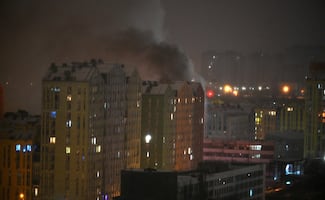Más Información

Lula conversa con Sheinbaum y extiende invitación para visita oficial a Brasil; ambos gobiernos condenan ataques a Venezuela

Juez da prórroga para cierre de investigaciones en caso del sujeto que acosó a Claudia Sheinbaum; audiencia será el 13 de enero

Tras descarrilamiento, Tren Interoceánico lanza nueva licitación para seguridad y vigilancia; firma convenio temporal para seguro de pasajeros

Cuerpo de Federico, niño de 2 años que falleció en accidente aéreo en Galveston, Texas, llega a Campeche; es velado en Escárcega
U.S. President Donald Trump signs an executive order formally withdrawing the United States from the 12-nation Trans-Pacific Partnership trade deal. Rough Cut (no reporter narration).
U.S. President Donald Trump formally withdrew the United States from the Trans-Pacific Partnership trade deal on Monday, distancing America from its Asian allies as China's influence in the region rises.
Fulfilling a campaign pledge to end American involvement in the 2015 pact, Trump signed an executive order in the Oval Office pulling the United States from the 12-nation TPP.
"Great thing for the American worker," Trump said as he signed the order on his third full day in office. The Republican says the trade deal would have damaged U.S. manufacturing.
The accord, backed heavily by U.S. business, was negotiated by former President Barack Obama's administration but never approved by Congress. It had been the main economic pillar of the Obama administration's "pivot" to the Asia-Pacific region to counter China.
Trump has sparked worries in Japan and elsewhere in the Asia-Pacific with his opposition to the TPP and his campaign demands for U.S. allies to pay more for their security.
Harry Kazianis, Director of Defense Studies at the Center for the National Interest think tank in Washington, said Trump must now find an alternative way to reassure allies in Asia.
"This could include multiple bilateral trade agreements. Japan, Taiwan and Vietnam should be approached first as they are key to any new Asia strategy that President Trump will enact,” he said.
U.S. BUSINESS LEADERS
The new president also met with a dozen American manufacturers at the White House on Monday, pledging to slash regulations and cut corporate taxes, but warning them he would take action on trade deals he felt were unfair.
Trump, who took office on Friday, has promised to bring manufacturing plants back to the United States - an issue he said helped him win the Nov. 8 election. He has not hesitated to call out by name companies that he thinks should bring outsourced production back home.
He said those businesses that choose to move factories outside the country would pay a price. "We are going to be imposing a very major border tax on the product when it comes in," Trump said.
Trump asked the group of chief executives from companies including Ford, Dell Technologies, Tesla and others to make recommendations in 30 days to stimulate manufacturing, Dow Chemical CEO Andrew Liveris told reporters.
Liveris said the CEOs discussed the border tax "quite a bit" with Trump, explaining "the sorts of industry that might be helped or hurt by that."
"Look: I would take the president at his word here. He's not going to do anything to harm competitiveness. He's going to actually make us all more competitive," Liveris said.
At a portion of the meeting observed by reporters, Trump provided no details on how the border tax would work. The U.S. dollar fell to a seven-week low against a basket of key world currencies on Monday and global stock markets declined amid investor concerns about Trump's protectionist rhetoric.
"A company that wants to fire all of its people in the United States, and build some factory someplace else, and then thinks that that product is going to just flow across the border into the United States - that’s not going to happen," he said.
CUT TAXES AND REGULATIONS
The president told the CEOs he would like to cut corporate taxes to the 15 percent to 20 percent range, down from current statutory levels of 35 percent - a pledge that will require cooperation from the Republican-led U.S. Congress.
But he said business leaders have told him that reducing regulations is even more important.
"We think we can cut regulations by 75 percent. Maybe more," Trump told business leaders.
"When you want to expand your plant, or when Mark wants to come in and build a big massive plant, or when Dell wants to come in and do something monstrous and special – you're going to have your approvals really fast,” Trump said, referring to Mark Fields, CEO of Ford, who sat around the boardroom-style table in the Roosevelt Room.
Fields said he was encouraged by the tone of the meeting.
"I know I come out with a lot of confidence that the president is very, very serious on making sure that the United States economy is going to be strong and have policies - tax, regulatory or trade - to drive that," he said.
Trump told the executives that companies were welcome to negotiate with governors to move production between states, but Trump was scheduled to hold a meeting later on Monday with labor leaders and U.S. workers, the White House said.
Between winning the presidential election in November and taking office, Trump hosted a number of U.S. CEOs in meetings in New York, including business leaders from defense, technology and other sectors. He also met with leaders of several labor unions, including the AFL-CIO.
Noticias según tus intereses
[Publicidad]
[Publicidad]










